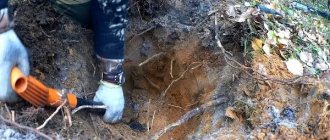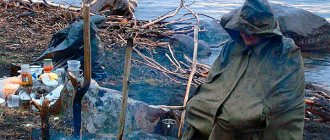Probably many outdoor enthusiasts: hunters, fishermen, diggers and others have had to spend the night in the forest at least once. It doesn't matter why it happened; a person got lost and couldn’t find his way before dark, or he deliberately decided to stay overnight. In any case, spending the night in the forest, especially alone, requires good preparation, otherwise it can result in at least a lack of sleep, or even more serious consequences. So, today we’ll talk about how to properly spend the night in the forest, what mistakes should be avoided and what to be wary of in the forest at night. Let me make a reservation right away that we are talking about the spring-summer-autumn season; winter overnight stays have slightly different features.
Preparation
It is advisable to start preparing your overnight stay a few hours before sunset. Of course, everything can be done at dusk and even at night with a good flashlight, preferably a headlamp, but in daylight almost everything can be done faster, easier and better. While the sun is in the sky, it is much easier to choose a parking spot, light a fire, put up a tent or hang a camping hammock, prepare firewood, cook food, etc.
Everything should be ready by sunset
Choosing a place to stay overnight
To prevent the night from turning into a complete nightmare, you need to choose your stopping place wisely. To do this, you should follow a few simple rules:
- The place should not be in a low area so that you do not get flooded if it rains. It is better to stop on a small hill.
- You should avoid areas with isolated trees, which are excellent targets for lightning. If the tree has already become a victim of lightning, then there is a small chance that treasure may be buried next to it, especially if the tree is located near a tract or a very old road. But that’s not about that now. Also, when choosing a place, make sure that nothing falls on you from above, which often happens under dry branches in a strong wind.
- There should be firewood nearby, and dry firewood. Dead trees that have not yet fallen are an excellent source of dry firewood even in rainy weather, just be careful if you decide to cut down such a tree.
- It would be nice if there was a source of water nearby, preferably running water. But this also has its own characteristics. Yes, running water is good, but the noise caused by it can cause auditory hallucinations, which is dangerous for an unprepared person. We'll come back to this a little later.
- And the general rule: when choosing a place, you should take into account the terrain, weather conditions and be sure to be guided by logic and common sense.
What should you do before dark?
So we chose a place to stay for the night, great. What to do next? Again, everything depends on the terrain and weather, so we’ll limit ourselves to general advice:
Bonfire. It can be placed in the place where you are going to put up a tent or make a bed and canopy from natural materials. You maintain it for several hours, cooking your dinner on it and boiling water, and then, when it burns out, simply move the coals to a previously prepared dug place, preferably in the wind, so that the eggs do not fly at you. And in the place where he warmed the ground, put up a tent or make a bed. This way you will sleep until the morning in a warm, dry place. If you plan to sleep in a hammock, then you do not need to warm up the ground underneath it. The fire can be anything you want. First, the simplest one will do to keep warm, dry things and prepare food, and for the night it’s better to pack some kind of long-burning one, like Nodi.
Firewood . They need to be stocked up in advance so that they last until the morning and in the middle of the night you don’t have to wake up and wander through the forest in the dark in search of them. As already mentioned, dead wood is excellent, as it burns well in any weather. The size of the firewood depends on the type of fire you choose, but long-burning firewood usually requires thicker logs. They say that if you line a large stump with firewood and set it on fire, it will burn until the morning. Sounds plausible, but I haven't tried it.
Water and Food . If there is a source of water nearby, then you should stock up on it by boiling it in the evening. It is also worth preparing yourself a hot dinner and having a good meal before going to bed in order to feel less cold and sleep better. Just be sure to remove leftover food, because... their smell can attract animals, encounters with which it is better to be wary.
Overnight . No matter how you decide to sleep: in a tent, a camping hammock or on a homemade bed, you need to make sure that the place is as dry, warm and comfortable as possible. It is advisable to build a canopy that will protect you from precipitation and reflect heat from the fire. Also, many advise marking your territory around the parking lot in the same way as forest dwellers do. It wouldn’t hurt to scatter a few cigarette butts around the perimeter, only in moderation, so as not to clog up the place too much. Animals have a keen sense of smell and are unlikely to enter your territory.
Night forest landscape
Overnight in the forest for beginners (1 photo)
Author: Mithun Chakrabortenkov
21 May 2021 15:28
Tags: survival animals overnight in the forest nature do it yourself
31859
1
One day I had the following conversation: “How do you spend the night in the forest?”
0
— In what sense “how”? I put up a tent and spend the night; in the summer I can do without a tent; if it’s dry, I throw my sleeping bag on the moss and sleep. - No, not in that sense. It's scary there, you're alone. “It’s not scary when you’re alone, it’s scary when someone is there.” Spending the night in the forest is less dangerous than going to a convenience store for a pack of dumplings. As a result, I decided to write a short note about spending the night in the forest. Let's start with how to approach the question. I reason like this: if I was born and raised on this planet, then my body is ideally adapted to its conditions, therefore, in the forest I am at home, and the city is an unnatural habitat for me. Having chosen a parking spot, I make a fire, set up a camp and, like any animal, mark the territory, namely, by walking around the camp in a circle with a radius of 30-40 meters, I relieve myself. After this, the animal will understand that I have indicated my presence, marked my territory, and will think once again whether it is worth poking into it. Smoke from a smoldering fire will complete the picture. If you smoke, a few gutted cigarette butts will give off a strong smell and mark the boundaries of your territory. Do not leave food supplies on the ground or on an improvised table; it is better to bury the leftover dinner immediately, this will once again protect the animals from the temptation to come near you. But there are such comrades as weasels and stoats, they will come simply out of curiosity, to see who has arrived. The hedgehog will definitely make a noise and puff unhappily near the tent. A larger animal will act more cautiously and will often not approach the camp until you leave it. Keep a supply of firewood in the camp for 4-5 hours of continuous burning, this is especially important at that time of year when the nights are long. A few liters of water won't hurt either. Some of my friends take 3-5 firecrackers with them on hikes. If you come across a particularly annoying animal, the roar, flashes and smell of gunpowder will instantly scare it away. If you have a dog with you, then you can generally sleep peacefully. I had a case where an English spaniel puppy stampeded a herd of wild boars. Of course, things can be different, but often animals show curiosity rather than aggression. Do not place a tent under tall trees, they can be struck by lightning, and after the rain it drips for hours, choose a flat place, preferably protected from the wind, build a fire at a distance from the tent, remember that pine loves to throw sparks and can burn the awning. Don't camp near a babbling stream, either in silence or near a loud stream. Auditory hallucinations occur from the sound of water. I knew about this fact and, nevertheless, one day, while pitching a tent on a stream, I heard a conversation between two men. I couldn’t make out the words, I understood that it was from a stream, but the effect of the conversation I had behind the tent was complete. Here, perhaps, are the main points. To summarize, I will say: for a comfortable overnight stay in the forest, the most important thing is psychological readiness; there is no extreme in forest life.
Source:
Related links:
- How to make a stylish silver bracelet
- This family turned their apartment into a paradise for their beloved cat.
- 20 Gorgeous Red Animals
- A girl built an amazing igloo house out of cardboard for a cat and here's how she did it
- 12 best homemade cardboard items for your favorite cats
Tags: survival animals overnight in the forest nature do it yourself
Did you like the post? Support Chips, click:
436 40 396
Liked
396 21
237
Partner news
Dangers
A person who decides to spend the night in the forest may face dangers, which we have already discussed in the article about searching for coins at night. But let us list the main ones:
- Wild animals . Even predators (wolves, bears) try to stay away from humans. In addition, the fire obviously will not make them want to come closer to you. But you shouldn’t forget about this, because... The leftovers from your dinner may attract animals, and some of them may approach you out of pure curiosity. Agree, it’s not very pleasant to wake up at night with a bear sniffing you. It's great if you have a gun at hand. If you don’t have a weapon, you can take a gas spray with you, which is great for scaring away wild dogs. There are special large gas cartridges for large animals such as bears. Ordinary firecrackers, flares or hunter's signals, which can also scare away unwanted guests, will also not hurt. Even if this is not the case, wild animals can be scared away by waving a burning stick.
It is better to avoid encounters with a bear
— Insects, rodents, poisonous snakes, etc. You can protect yourself from mosquitoes with repellents and a mosquito net, or even smoke from a fire by throwing green grass or leaves into it. Rodents, despite their apparent harmlessness, often turn out to be carriers of dangerous viruses, so it is imperative to protect water, food and utensils from them. Observation and attentiveness will save you from snakes, and in case of a bite you will need special medications and first aid skills. In my area, fortunately, there are no snakes, as in many others.
- Unfriendly people. Among diggers, hunters (real hunters, not poachers), fishermen, and even more so tourists, there are very few ill-wishers and inadequate aggressive individuals. A chance meeting with them rarely turns into trouble. In my opinion, the first thing to be wary of is local residents, especially those who are tipsy, if the place where you spend the night is located near populated areas. Most often, conflicts occur with locals, as well as with unscrupulous representatives of authorities or professions such as huntsman or forester. In any case, it is better to have self-defense means with you, at least a gas spray, because... It’s stupid to rely on your own strength, especially if there are several opponents, which often happens. But it is better to try to avoid such situations and choose a place to spend the night away from populated areas and roads, including forest ones.
- Cold. Even in the summer, nights can be incredibly cold, which can result in colds, pneumonia, or even severe hypothermia, which can be fatal in particularly severe cases. Therefore, when going into nature for the night, you should not neglect warm clothes and equipment, and also take a competent approach to lighting a fire and arranging your overnight stay.
These are the obvious dangers that can await a person who decides to spend the night in the forest. But as in the case of a night cop, great attention should be paid to psychological preparation.
Leshii, women, witches, ghosts and other hallucinations
It was not in vain that we said that it is better to choose a parking place where there is no monotonous noise such as a babbling stream. This noise can cause auditory hallucinations. Therefore, the place should be either in complete silence or in a noisy place, for example, next to a waterfall, the loud noise of which will drown out other sounds. Of course, absolute silence cannot be achieved no matter how hard you want; you will still hear the rustling of leaves, the howling of the wind, the sound of rain, or the unexpected cries of the inhabitants of the night forest, which make you flinch at first. But many advise avoiding the sound of flowing water.
The nature of the occurrence of auditory hallucinations is quite simple. The human brain has one interesting feature of looking for patterns in any randomness. Those. in ordinary noise, our subconscious tries to identify familiar sounds like people’s voices, a crying child, and the like. Some also explain this as an electronic voice phenomenon. Our brain not only selects individual frequencies from the general polyphony that are close to the human voice, but also adds missing elements to these passages. Thus, it seems to us that we hear people's voices or other sounds where they simply cannot be. And this phenomenon is perceived so realistically that it can greatly shake even a strong psyche. The situation is aggravated if a person is unfamiliar with this phenomenon and believes in all sorts of goblin and other bogus stories. But there are quite a lot, if not the majority, of superstitious people among lovers of outdoor recreation.
In the dark you may not see such things
This applies not only to sounds. Often in twilight or darkness, and even in fog in the moonlight, a person can imagine anything. The scheme is the same: the brain sees a bush that vaguely resembles a person in outline, adds the missing details to this image, and now it seems to you that someone is standing in the distance and watching you. Even a non-superstitious person who is familiar with such features of the human psyche and the nature of hallucinations can lose sleep at night due to such phenomena.
You can give various examples for a long time and listen to similar stories that can be found in almost every hunter or digger who is especially superstitious. There are even places where people experience inexplicable fear. Every second treasure hunter or person who often spends time in nature will confirm this to you. If you have chosen a parking spot, but are experiencing some inexplicable anxiety and even fear, then it is better to look for another place. Otherwise, you risk at least not getting enough sleep.
In such situations, it is easiest for a person who does not believe in the supernatural and who is confident that absolutely any phenomenon has a rational explanation. But even he alone in the forest at night will most likely experience, if not fear, then some psychological discomfort. This is the nature of our psyche.
Overnight in the forest. How not to freeze...
Imagine a situation of extreme survival in cold weather conditions, when your clothes are not able to protect your body, and the appropriate equipment is not available at all, or it is very limited and ineffective. An exhausted person at risk of hypothermia needs to sleep, but you know that you will never wake up if you pass out.
I will tell you how to survive in such a situation. There is a way that can provide a comfortable, warm place to sleep in severe weather even if your clothes are not adapted to low temperatures and you have virtually no equipment or special survival skills in the wild, other than the ability to build a special place to sleep and light a fire. . In fact, you will have to take a lot of care to ensure that this “bed” is cool enough to sleep in!
A special “bed” for survival that will allow you to stay warm in cold weather and can save your life is called a “ fire bed ” or “ coal bed ”.
Before I start explaining how to build a place to sleep, I would like to emphasize that if you are not in a real survival situation, but just practicing, try to pay special attention to the issue of preserving the environment with minimal damage from your actions. Avoid damaging tree and plant roots and be careful with fire in the wild.
Show respect for nature and it will definitely take care of you!
Requirements for building a "fire bed"
Since creating a “charcoal bed” requires a lot of time and effort, it is important to first find a suitable location. You need to look for various features that will make the construction of the “bed” easier, as well as the natural materials needed to build it and create additional comfort.
Preferred areas:
- Protected as far as possible from wind, rain and snow.
- With soil that you can dig down to about thirty centimeters without encountering large rocks, tree roots, ice or water.
- Places rich in dry fuel to support fire. Hard deciduous trees are preferred. They burn longer and create a hotter flame. Soft rocks burn quickly and produce a lot of sparks.
- Places with plenty of dry bedding material (leaves, pine needles, grass, cattail, etc.) to insulate the body.
Let's look at each point in more detail.
Weather protected areas
If possible, choose a place with natural shelter. Rock ledges, overhanging thick trees, and even the roots of fallen trees can provide good shelter compared to open areas. You will need to find a piece of flat ground that is at least half a meter or a meter longer than your body and wide enough to sleep comfortably.
Suitable soil for digging
Since you will be digging a hole in the ground, choosing the right soil is essential. Give preference to areas where:
- Groundwater is not close to the surface. If you reach water, you need to dig in another place.
- The soil is easily cultivated with improvised means.
- There are few roots or large stones that make the work very difficult.
- In snowy areas, look for a place where you won't have to dig too deep into the ground.
If you don't have a shovel for digging, don't despair! Use your own cutlery set, a knife, a sturdy stick, or even your own hands.
Typically, in cold climates the soil freezes to a considerable depth. Depending on the situation, you may find soft ground at the base of south-facing slopes where the sun's rays warm the ground sufficiently. Or you can build a fire to melt the soil layer before digging.
Fuel for the fire
A good “charcoal bed,” as the name suggests, requires a layer of hot, long-smoldering coals. For this reason, the best fuel for building such a “bed” is hardwood. If possible, locate your overnight camp near a source of dry fuel.
Softwoods can also be used, but they are not capable of creating the high-quality coals more typical of hardwoods. Dry grass and other natural materials do not leave embers, but can be used to start a fire and warm the ground.
Hard tree species : hornbeam, eucalyptus, pear, cherry, apple, elm, teak, hickory - North American hazel, beech, oak, birch, ash, maple, walnut.
Soft tree species : linden, spruce, fir, aspen, cedar, alder, hemlock, pine, chestnut, willow.
Insulation material
If you don't have enough warm clothing and sleeping gear is poorly suited to cold climates or completely missing, you will need a good source of dry, soft material for insulation and upholstery. Typically, the forest floor is a nice natural "blanket" of leaves, evergreen needles and grass.
Even in areas with deep snow cover, if you try hard, you can find insulation material. Inspect large boulders, where the ground around the stone is often not covered with snow and dry leaves accumulate there (by the way, a good place to settle down for the night). Check south-facing slopes and patches of evergreen forest, which tend to be less snowy.
In winter, wet areas (swamps, rivers, lakes) can provide excellent insulation material in the form of cattails and reeds. These plants are easy to reach, since all the water freezes and the snow is blown off the smooth icy surface.
Canvas or tarpaulin, wool blanket, polyethylene or other similar material (waterproof and/or heat retaining) can be a great help.
Survival situation
Let's imagine that your truck breaks down in a remote mountainous area and you have to sleep outside in cold weather without special equipment. Your clothing consists of sneakers, thin cotton pants, a T-shirt, a cotton jacket and a cap. Of course, you had to use a three-layer clothing system, but no one could have imagined that the truck would ever break down - this is the main mistake in the mountains.
You also have a folding army shovel, an old wool blanket and the ability to start a fire (flint, matches, lighter, you can use a car battery or even a cell phone battery).
You can make a “fire bed” without a blanket or a shovel, but without fire you won’t be able to do anything. Therefore, it is extremely important to always have an emergency kit with you, which will contain waterproof matches or, better yet, a flint and a magnesium block.
To work
As soon as you decide on a place, start digging a trench of the following dimensions: width - about 30-50 cm, length - about 180 cm, depth - 30 cm. Do not scatter the earth at random, but carefully put it in a heap. We will need stones later, so separate them from the general soil.
Once the trench is ready, line the bottom with fist-sized stones, leaving a gap of 2-4 cm between them. Stones, in principle, are not an absolutely necessary condition, but they will help create an air gap so that the fire will be hotter and better coals will be obtained. If you do not find enough stones while digging, you can look for them somewhere nearby, just do not collect porous or layered stones, or those that were in water. may explode when heated !
Now you can light a fire. For tinder I used dry pine needles and a pine cone. When the fire flares up and the first coals appear, scatter them throughout the entire trench so as to cover the maximum area. Our goal is to maintain an even fire to create coals and warm the soil around the entire perimeter of the trench. Add firewood as needed and spread the coals over a period of 2-3 hours. This time can be used for cooking, boiling water, and drying clothes or bedding materials.
Then sprinkle the coals with a 10-centimeter layer of soil and tamp it down well. Make sure that all coals are well covered and that steam or smoke does not break through the soil layer.
That's it, now all we have to do is wait. It should take an hour or so before you feel the pleasant warmth of the heated ground. If this happens earlier, then most likely you need to add another 3-5 cm of soil from above, otherwise your “bed” may turn out to be too hot for a comfortable overnight stay.
All that remains is to prepare the “mattress”. Look for dry, soft material and pile it up. Once the coals have sufficiently heated the surface of the trench, you can cover the soil with an even layer of insulating material. The thickness and amount of insulation depends on the specific conditions and your capabilities. It is recommended to use a layer of at least 20-30 cm in thickness.
Several logs laid parallel to the sides of the trench will reflect the heat and keep you warm. In addition, they will serve as a windbreak and will not allow you to slide onto the cold ground.
results
When I made this bed, the ambient temperature was about -4 degrees Celsius. Four hours later, the surface temperature of the soil above the coals reached 43 degrees, and the ground within a radius of 30 cm from the trench was slightly warm. By changing the thickness of the bedding material, you can regulate the temperature of the “fire bed”.
The main problem when using such an overnight stay is evaporation. The fact is that the soil and/or material used for insulation usually contains moisture. As a result, the heat from the coals turns moisture into steam and you get something like a sauna. For this reason, it is advisable to use only the driest body insulation products. If possible, lie down on a waterproof material (plastic, tarpaulin, canvas, polyethylene).
The next morning, fourteen hours after the “bed” was built, the air temperature dropped to -8 degrees Celsius, and the ground surface temperature was still around 32 degrees. This is an excellent result!
This technique of creating a comfortable, warm place to sleep will allow you to survive in cold weather without equipment or special clothing. Good luck!
Conclusion
Despite all of the above, spending the night in the forest is no more dangerous than, say, an ordinary walk around the city. Of course, this statement is true only with proper preparation, equipment, a strong psyche, skills and, preferably, experience. Even 100 years ago, our ancestors could easily spend the night in the forest without any equipment or various fears. For us, this is a real adventure and in some ways even extreme. This is because we are used to living in cities and the forest is, although not hostile, an unnatural habitat for us.
Write in the comments what you think on this issue. Surely there is something to add, because I definitely missed something)
Basic fears in the forest: why is spending the night in the forest so scary?
People are generally afraid of the forest. This happens on a subconscious level due to the fear of wild animals and, in general, everything unknown that can await a person in an unfamiliar environment. And the forest is really full of all kinds of sounds. This fear especially intensifies at night, when, willingly or unwillingly, you begin to listen to everything that seems even a little suspicious. And there are a lot of such sounds in the forest at night. These are birds, small animals and even the wind that moves the forest. It seems that someone is about to sneak up and pounce to destroy you. However, practice shows that no one will come. But you can only realize this by having the practice of spending the night in the forest. At the same time, there is a problem with wild animals. Especially if such an overnight stay is in places where they may be. First of all, these are difficult to reach places, far from populated areas.










